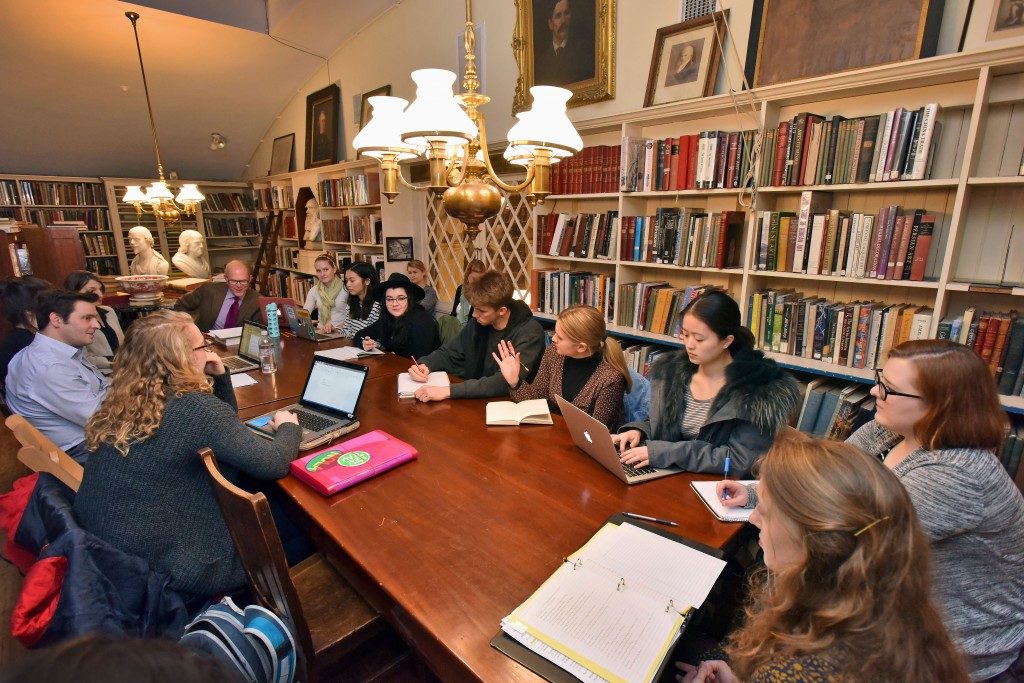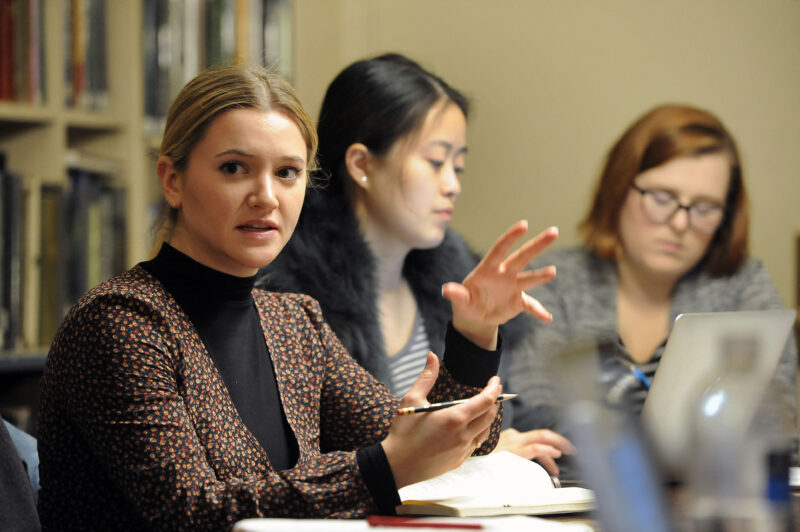Uncovering stories
These are some of the questions that the students in Professor of Art Tripp Evans’s “Cataloguing Curiosity” course considered this spring as they sat together in the art room of the Providence Athenaeum, amid tightly packed bookshelves, stone busts and oil portraits.
They were helping to bring to light the stories of the athenaeum’s collection through scholarly research that will be shared with the public. Once a hybrid between a library and an art museum, the Providence Athenaeum is a member-supported institution founded in 1836. It has deep roots in local history and a diverse collection of art that complements its extensive literary holdings.
While much of its art is on public display, athenaeum staff lack the time for the extensive research needed to make the whole collection accessible to visitors and scholars.
Evans, who serves on the athenaeum’s board of directors, and Kate Wodehouse, the athenaeum’s director of collections and library services, recognized this problem as an opportunity.
“When we struck on the idea to engage Wheaton students in this process—a project that would enlist them in ‘real world’ art history research and sharpen their professional writing skills—I knew we’d found a perfect partnership,” said Evans, Mary L. Heuser Chair in the Arts at Wheaton.

The 10 students in the “Cataloguing Curiosity” senior seminar explored the athenaeum’s full art collection of more than 100 pieces during the spring semester. Their findings will appear on the athenaeum’s website, and there are plans to include them in a book.
The task was highly collaborative: Students traveled together in groups to the athenaeum and the Rhode Island Historical Society, where they found resources with help from staff and shared findings with each other.
“Personally, the best part of the project was working closely with the students,” said Wodehouse. “I enjoyed assisting them in their discoveries, but ultimately they were responsible for the work that they were producing. They contributed many hours of research and analysis that we would never be able to accomplish with our limited resources. This project will provide a substantial and lasting contribution to the athenaeum.”
Added Evans: “Collaborations like these not only demonstrate the tremendous value of the humanities, on a communal and individual level, but they also reinforce for our students that service and learning go hand in hand.”
The work was a challenge for students who are used to finding a lot of their information online.
“Although fascinating, this kind of research is time-consuming and often leads to dead-ends,” said Emma Wynne ’18, an art history and German studies double major. “I’ve used exhibition catalogs, books, online encyclopedias, museum websites, and for the first time, I have done primary research at a historical society. At the Rhode Island Historical Society, I had to use an actual card catalog to search for genealogical sources, which were one-hundred-year-old documents.”

“I have taken plenty of art history classes since it’s my major,” said Ceara Bowman ’16, who is also a member of the swimming and diving team. “This class has definitely been the most unique because its subject—libraries and athenaeums—is not something I have ever studied through the lens of art history. In the previous semester I took Leah Niederstadt’s ‘Museum Studies’ course, where we researched the provenance of objects in Wheaton’s own Permanent Collection. Coming off that project and onto this one has truly strengthened my research skills.”
Not only were they mastering the skill of professional cataloging, which is rare for undergraduates, according to Evans, but they also found themselves drawn into the stories they were uncovering.
“Providence artist Whitman Bailey’s drawing of the athenaeum has been my favorite piece to research,” said Bowman. “I have learned not to dismiss any form of information—anything can be unexpectedly useful. Just today, I discovered an article that Bailey wrote for the Providence Magazine in 1870, where he described an enlightening experience he had while falling asleep at the athenaeum. He dreamed that some of the same objects that we’re researching literally came to life. His words brought those objects to life for me, too.”